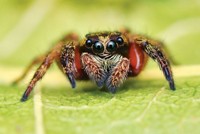Advertisement
Grab your lab coat. Let's get started
Welcome!
Welcome!
Create an account below to get 6 C&EN articles per month, receive newsletters and more - all free.
It seems this is your first time logging in online. Please enter the following information to continue.
As an ACS member you automatically get access to this site. All we need is few more details to create your reading experience.
Not you? Sign in with a different account.
Not you? Sign in with a different account.
ERROR 1
ERROR 1
ERROR 2
ERROR 2
ERROR 2
ERROR 2
ERROR 2
Password and Confirm password must match.
If you have an ACS member number, please enter it here so we can link this account to your membership. (optional)
ERROR 2
ACS values your privacy. By submitting your information, you are gaining access to C&EN and subscribing to our weekly newsletter. We use the information you provide to make your reading experience better, and we will never sell your data to third party members.
Biomaterials
Beetle shells provide beauty and brawn
Microstructures in flower beetle exoskeletons are multifunctional, providing optical brilliance and mechanical strength
by Emily Harwitz
July 10, 2021
| A version of this story appeared in
Volume 99, Issue 25

The microstructures that give flower beetles’ exoskeletons their dazzling iridescence also enhance structural strength, according to a research team led by mechanical engineer Ling Li of Virginia Tech (Proc. Natl. Acad. Sci. U.S.A. 2021, DOI: 10.1073/pnas.2101017118). The team of multidisciplinary experts from six universities came together to investigate the relationship between the optical and mechanical properties in the colorful shell of the flower beetle—namely, how does the shell provide visual cues and protection, and is there a function that’s prioritized? Using a scanning electron microscope to analyze the shell, the researchers found vertical micropillars supporting alternating nanoscale layers of exoskeleton material in a plywood-like structure. Experimental and theoretical analyses revealed that the micropillars scatter light in a way that maximizes the viewing angle of the reflected color. The micropillars also give the exoskeleton flexibility and damage tolerance, like holding a seal around a puncture site to prevent further damage. Optical and mechanical models show that more micropillars would increase strength but decrease structural color. After analyzing a range of beetle color morphs, the researchers found that the micropillars seem to be distributed for maximum optical performance rather than mechanical properties. These results provide a window into how unique multifunctional materials evolve in nature to cope with evolutionary pressures, and they could inspire mechanically robust photonic materials.





Join the conversation
Contact the reporter
Submit a Letter to the Editor for publication
Engage with us on Twitter